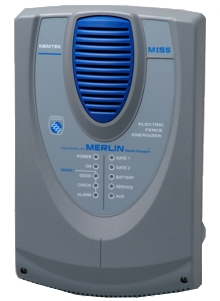Why choose electric fencing?
- It provides dependable boundary protection.
- It is not affected by vibration or adverse weather
- It can be interfaced with other security products such as CCTV
- It is safe and complies with HSE guidance
- It will be installed by a Secured by Design approved installer
Range Summary
Electric fencing can be manufactured to the height required.
Common Applications
- External storage
- Supermarkets
- Government buildings
- Commercial sites
- Distribution companies
- High security
- Builders' merchants
- Car compounds
- Residential homes
An electric fence system consists of a device called a power energizer, a length of bare wire and a rod used to lead the electricity into the ground. Any other enclosure involved, such as a chain link fence or razor wire barrier, would be more accurately described as an electrified fence. The power energizer may draw its power from a standard 110v or 220v outlet, but the actual amperage is often commuted down considerably. Every second or so, a pulse of high electrical energy is sent down the wire from the energizer to the grounding rod.
The amount of electrical energy generated by an electric fence can vary from annoying to lethal. The main purpose of most electric fence systems is to delineate a boundary and strongly encourage livestock to remain within it. Would-be intruders also receive a discouraging jolt if they make direct contact with the bare wire. There is rarely a need for lethal levels of electricity in standard electric fence systems designed for livestock restraint.
Instead of increasing the electrical charge on an individual wire, those who seek a stronger system often add more wires at varying heights. Horse owners using an electric fence may use six or more lines to prevent their animals from leaping over traditional fencing. The voltage may also be increased in order to discourage large animals from crossing the boundaries. Smaller animals such as domestic dogs usually don't require such elaborate systems; one or two wire electric fence systems should be sufficient.
Certain places have special permission to use lethal levels of current in their electric fence barriers. Prisons, military installations and vital utility substations may employ highly-charged electric fences to strongly discourage escapes or vandalism attempts. Warning signs must be posted in order to reduce the chances of accidental contact with the protective electric fence.
The use of an electric fence may be strongly regulated by city ordinances or state laws. In general, an electric fence should only be supplied with enough power to be effective, not lethal. The effect of most electric fence encounters is a sharp shock, much like the stinging sensation of a snapped rubber band. Animals who brush up against a charged electric fence should get the idea to recoil, but not suffer electrical burns or other injury.
Private electric fence owners can often be held liable for any injuries or deaths caused by their enclosures, so it pays to be conscientious. Deterrence, not destruction, should be your guide when setting the proper power level of a personal electric fence system.
|



